Somewhere in Bavaria, medieval castles, winding hiking trails, and inviting breweries all meet in one place. That’s Franconian Switzerland, a region hidden between Nuremberg, Bamberg, and Bayreuth in southern Germany.
Rolling hills, tucked-away caves, and tiny villages surround the area. I quickly realized it’s the perfect escape for anyone who loves both the outdoors and a good pint.
My adventure through Franconian Switzerland felt like a dream for hikers and beer lovers. Scenic routes connect ancient castles, limestone caves, and traditional breweries. Each day, I found a new path—sometimes across meadows, sometimes along rocky cliffs. And every hike finished with a hearty meal and a cold, local beer.
If you’ve ever wanted to wander through one of Germany’s most charming landscapes while sampling some of the best local brews, Franconian Switzerland is an experience you won’t soon forget.
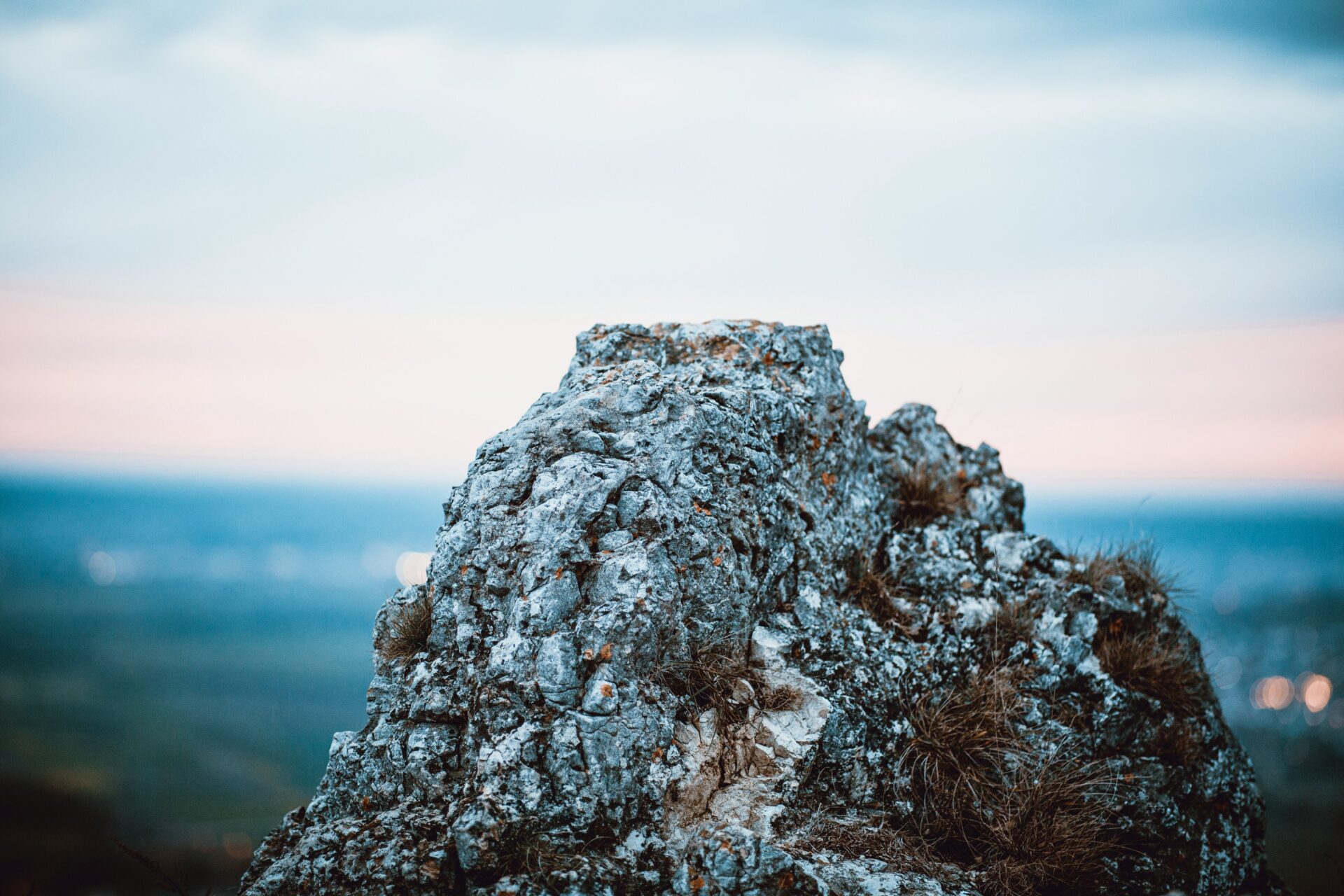
Getting to Know Franconian Switzerland
Rugged cliffs, historic breweries, and picturesque villages all nestle between dense forests and winding rivers. The region fascinated me with its blend of old-world charm and natural beauty. It’s both scenic and full of culture, right in the middle of Bavaria.
Where Is Franconian Switzerland?
Franconian Switzerland sits in northern Bavaria, in Franconia. It’s tucked between Nuremberg, Bamberg, and Bayreuth, forming a scenic triangle that feels far from city life.
I got there easily by train or car from Nuremberg—less than an hour away, honestly. The area is part of Upper Franconia and covers over 2,300 square kilometers. Towns like Ebermannstadt, Pottenstein, Forchheim, and Gräfenberg make great starting points for exploring caves, castles, and, of course, breweries.
Public transport connects most villages, but having a car really opens up the hiking trails and those hard-to-reach spots.

A Brief History of Bavaria’s Magical Region
People have lived here since prehistoric times, drawn by the many limestone caves. Romans, Celts, and medieval knights all left their marks on the land.
Artists in the early 1800s called it “Franconian Switzerland” because the rocky hills reminded them of Switzerland. As I wandered through old fortresses and castle ruins, I felt like I’d stepped into a world of ancient dukes and local legends.
Many castles, like Pottenstein Castle and Greifenstein Castle, have stood for centuries. Traditional breweries—some family-run for generations—fill the villages with the rich scent of malt and hops. Brewing is a huge part of local life here.
The region keeps its rustic, historic character, mixing Bavarian spirit with deep Franconian roots.

The Charm of Upper Franconia and Local Towns
Every town I visited felt different. Ebermannstadt has a classic Franconian old town and is perfect for starting hiking adventures.
Pottenstein stands out for its caves, a fun summer luge track, and castles perched above the valley. Forchheim draws you in with timbered houses and beer cellars that buzz in summer.
Gräfenberg? It’s got more breweries per person than just about anywhere—a paradise for beer fans.
Bayreuth, a bit farther east, is famous for its opera festival and Baroque palaces. It’s a cultural gateway to the region. I loved sampling hearty Franconian food in family-run taverns and wandering quiet cobbled streets that haven’t changed in ages.
Here’s a quick look at some of the key towns:
| Town | Known For |
|---|---|
| Ebermannstadt | Old town, hiking trails |
| Pottenstein | Caves, castles, luge track |
| Forchheim | Beer cellars, timbered houses |
| Gräfenberg | Many small breweries |
| Bayreuth | Culture, Baroque palaces, opera |
The warmth and authenticity in these communities made every stop feel like a real discovery.
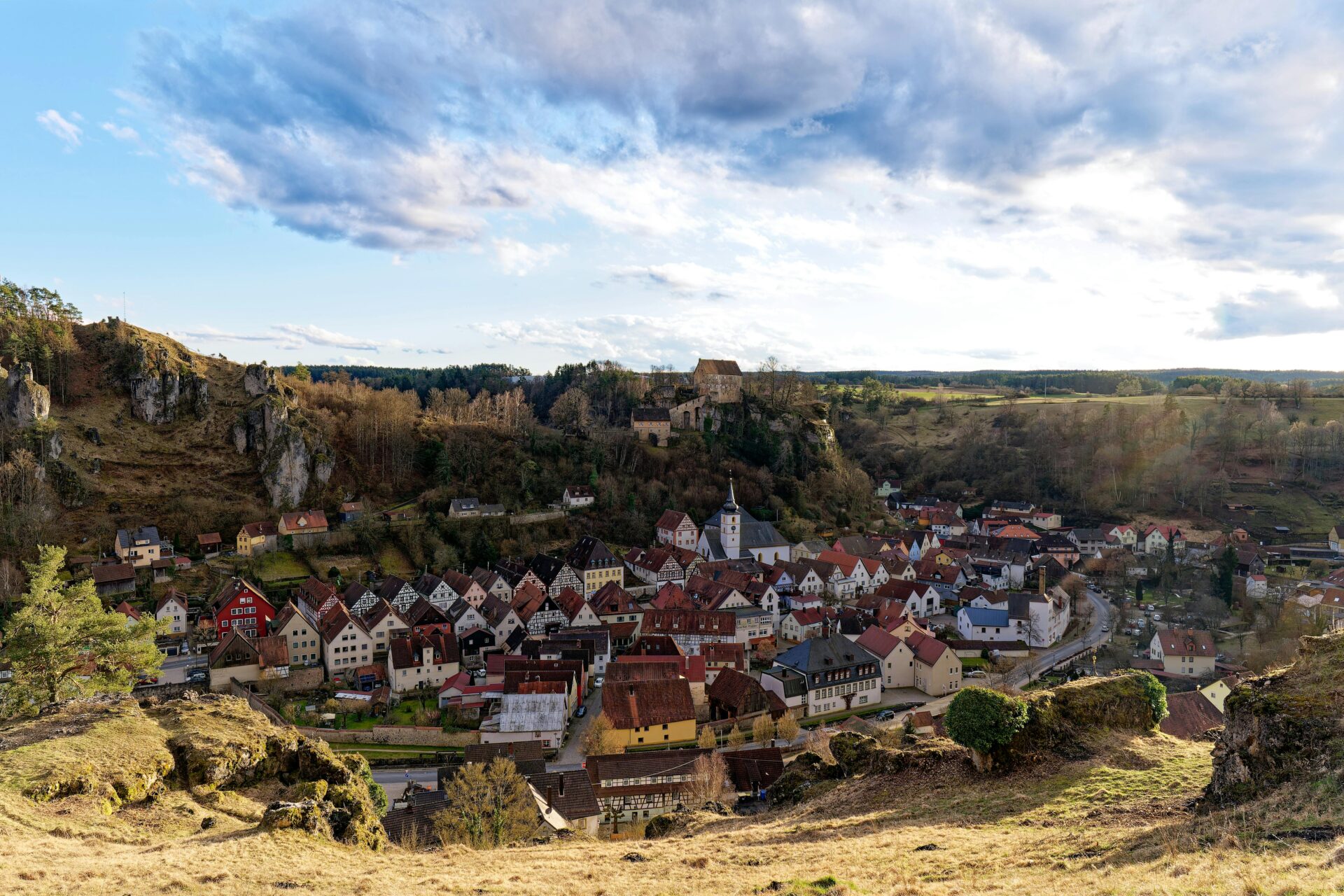
A Hiker’s Paradise: Trails, Castles, and Jaw-Dropping Landscapes
When I explored Franconian Switzerland, I found nature, history, and adventure all mixed together. Ancient castles and rocky cliffs rise above pretty villages, and endless trails wind through thick forests and open hills.
Epic Hiking Trails and Scenic Routes
Hiking here felt like stepping into a storybook. Well-marked trails led me past fields, rivers, and old stone bridges.
Some of the best routes are the Franconian Mountain Path and the trails around Pottenstein. Each one gave me a fresh view of the region.
I especially liked the brewery trail—small local breweries linked by scenic walking paths. The hikes weren’t too tough and there were always spots to rest or grab a snack.
Trail maps posted in villages like Egloffstein and Waischenfeld helped me find my way. The views over the Regnitz River valley, especially in the early morning fog, were just stunning.
| Trail Name | Length | Highlights |
|---|---|---|
| Franconian Mountain Path | ~430 km | Castles, caves, rock formations |
| Pottenstein Adventure Loop | ~12 km | Caves, castle ruins, brewery stops |
| Brewery Trail | ~15 km | Local beers, scenic villages, easy walking |

Rock Formations and Panoramic Views
The region’s rock formations are wild—full of strange shapes and towering cliffs. I saw jagged sandstone spires and natural arches that seemed to pop up out of nowhere.
Many trails took me right up to these giants, and sometimes there were ladders or steps built into the stone so you could climb higher.
When I hiked above Tüchersfeld, the cliffs made me stop and just stare for a while. Sweeping panoramic views were everywhere, especially around Pottenstein and the limestone ridges north of Waischenfeld.
Several overlooks had benches—perfect for a lunch break with a view. Sometimes I just listened to the wind and birds echoing off the rocks. That peacefulness, mixed with the dramatic scenery, kept me wandering, always curious about what was around the next bend.
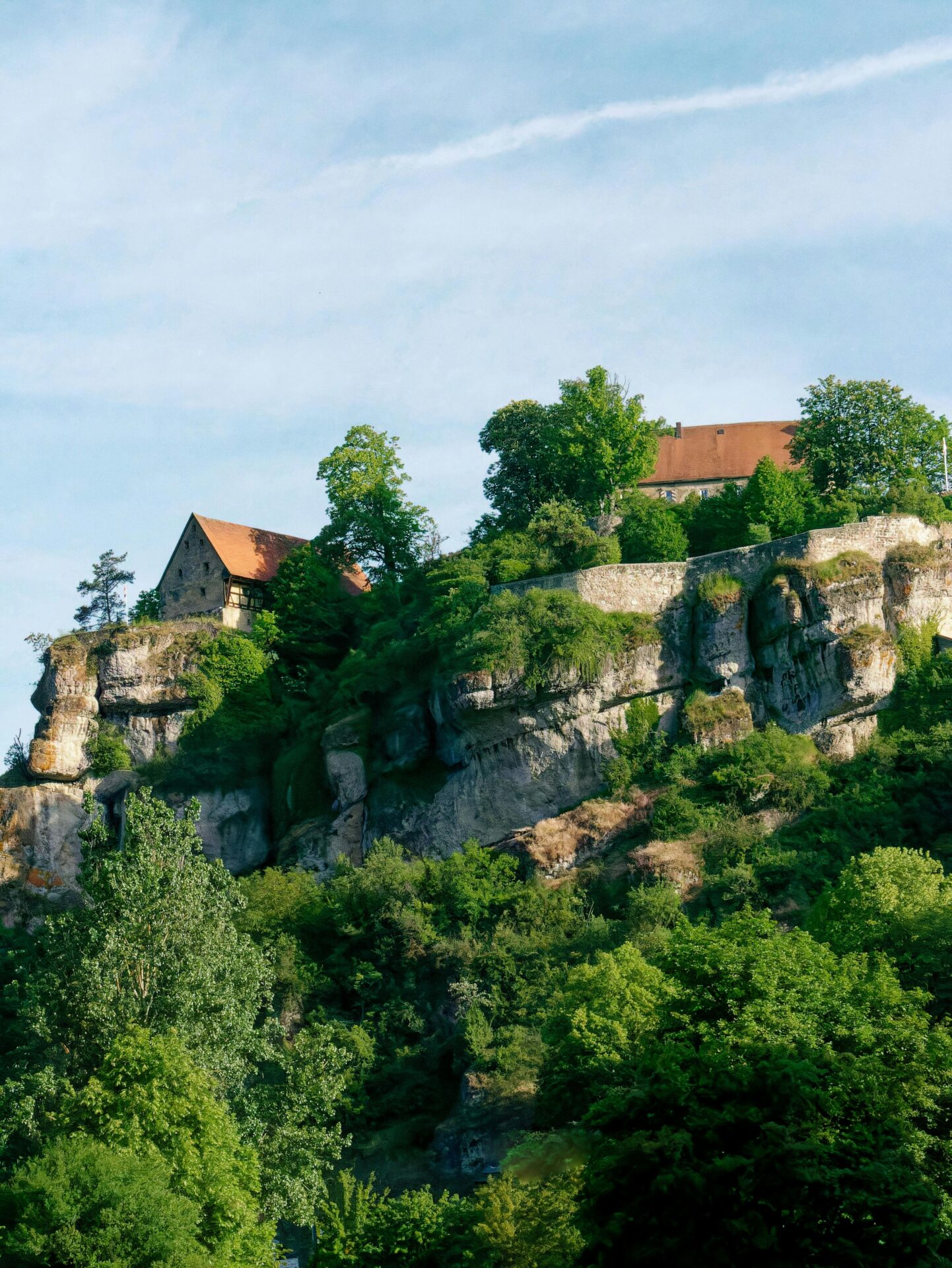
Castles, Ruins, and Medieval Towns
No hike here felt complete without a castle or ruin along the way. The area is packed with medieval fortresses—thick stone walls, towers, and secret stairways.
Some of my favorites were Pottenstein Castle, which has amazing views over the town, and Egloffstein Castle, which is still lived in today.
The ruins of Waischenfeld Castle gave me a taste of history, mixed with local legends. I could spot castle ruins perched on high rocks, which made for dramatic photos.
It seemed like every town, no matter how small, had some hidden medieval history—a castle, an old gate, or a cobbled lane.
I also took day trips to see the famous Veste Coburg and walked stretches of the Romantic Road to explore villages like Dinkelsbühl and Rothenburg ob der Tauber. Each place felt frozen in time and added to the adventure.
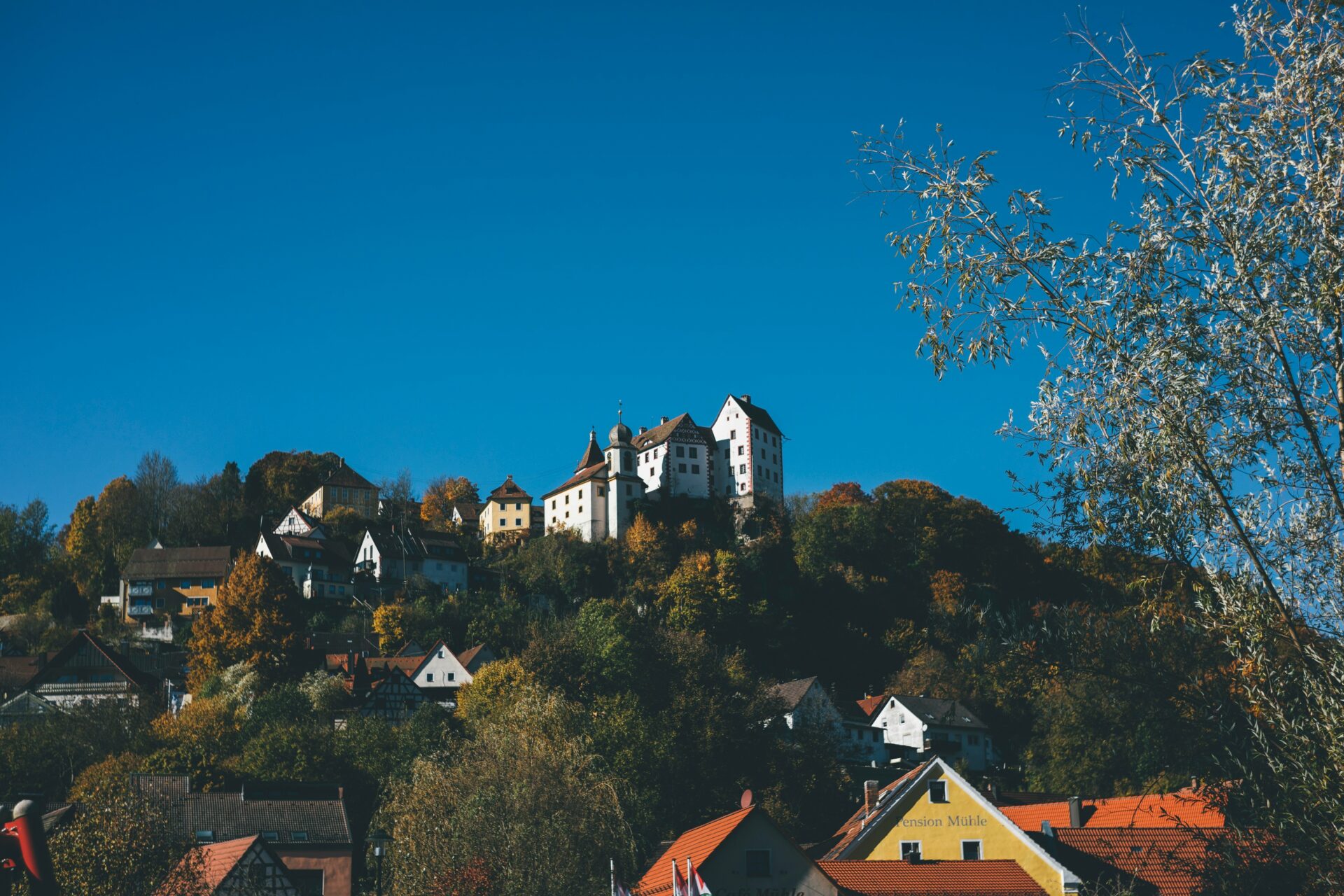
Adventure Activities: Rock Climbing and Kayaking
Adventure lovers, you’ll find plenty to do here. I tried rock climbing—those limestone cliffs are popular with both beginners and seasoned climbers.
Climbing gardens are set up near most major trails, and you can book a guide for lessons if you’re new to it.
On warm days, I went kayaking and canoeing on the calm stretches of the Pegnitz and parts of the Main River. The water is gentle, and the rivers cut through beautiful gorges and peaceful forests.
Paddling around bends, I caught glimpses of castles perched high above the water. That view is something I’ll never forget.
Hiking, climbing, paddling—there was always something new waiting. Franconian Switzerland turned into a real outdoor playground for me, packed with challenges and gorgeous scenery.
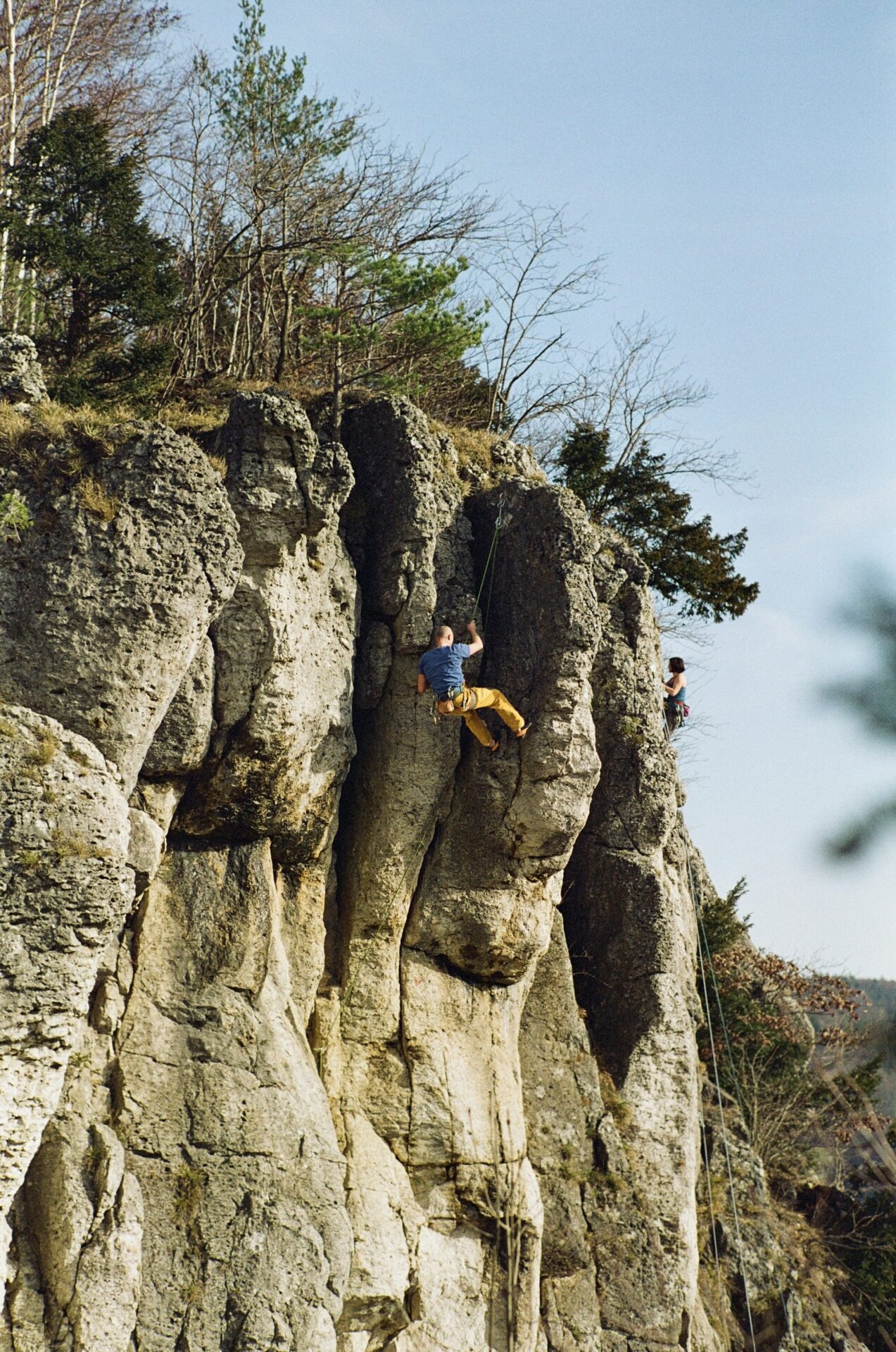
Caves, Legends, and Underground Marvels
Franconian Switzerland hides more than 1,000 caves beneath its rolling hills. Huge chambers, wild rock formations, and ancient legends fill these underground worlds. Every cave has a story, and I couldn’t resist exploring a few on foot.
Teufelshöhle: The Devil’s Cave Experience
Just outside Pottenstein, Teufelshöhle (Devil’s Cave) really lives up to its name. Its entrance yawns open in the limestone rocks, and stepping inside felt like entering another world.
Guided tours last about 45 minutes and follow paved, well-lit paths.
Inside, I wandered through stunning chambers filled with stalactites and stalagmites of every shape and size. The Barbarossa Dome—the cave’s biggest hall—stretches almost 18 meters high and 11 meters wide.
I get why rock climbers and photographers love this place.
Legend says the cave once hid people and hosted mysterious rituals, which adds a cool layer of intrigue for anyone into history or folklore. If you’re in Pottenstein, don’t skip this cave.
Quick Facts – Teufelshöhle:
| Feature | Detail |
|---|---|
| Location | Pottenstein |
| Tour Length | 45 minutes (guided) |
| Major Attraction | Barbarossa Dome |
| Accessibility | Paths are well-maintained |

Binghöhle: A Journey Beneath the Surface
In Streitberg, not far from Pottenstein, I found Binghöhle, which stands out for its colorful calcite formations and gentle underground streams.
The guided tour weaves through well-lit corridors lined with flowing curtains, pillars, and sparkling crystals. Binghöhle’s narrow passageways made it feel adventurous, but it’s still good for both adults and kids.
I learned how slow, mineral-rich water shaped the cave over thousands of years. Along the way, displays share cool facts about geology and cave life.
Unlike Teufelshöhle, Binghöhle feels more intimate, and the sparkling mineral deposits almost twinkle in your flashlight. It’s a great stop for curious travelers who want to see how water shapes the world from below.

Sophienhöhle and the World of Stalactites
Sophienhöhle sits in the Ahorn Valley, surrounded by forest, and is famous for its impressive stalactite formations. Guided tours take you deep into three main chambers, each packed with mineral wonders.
The “Throne Room” amazed me—massive stalagmites rise up like pillars in a hidden palace. Sophienhöhle is also known for its Ice Age animal remains, including a cave bear skeleton on display in the first chamber.
Light playing on the crystal formations creates a magical, otherworldly feel. For geology fans, prehistory buffs, or anyone who loves stunning scenery, Sophienhöhle is a real highlight.
It’s easy to reach by foot, so it’s popular with hikers and families.
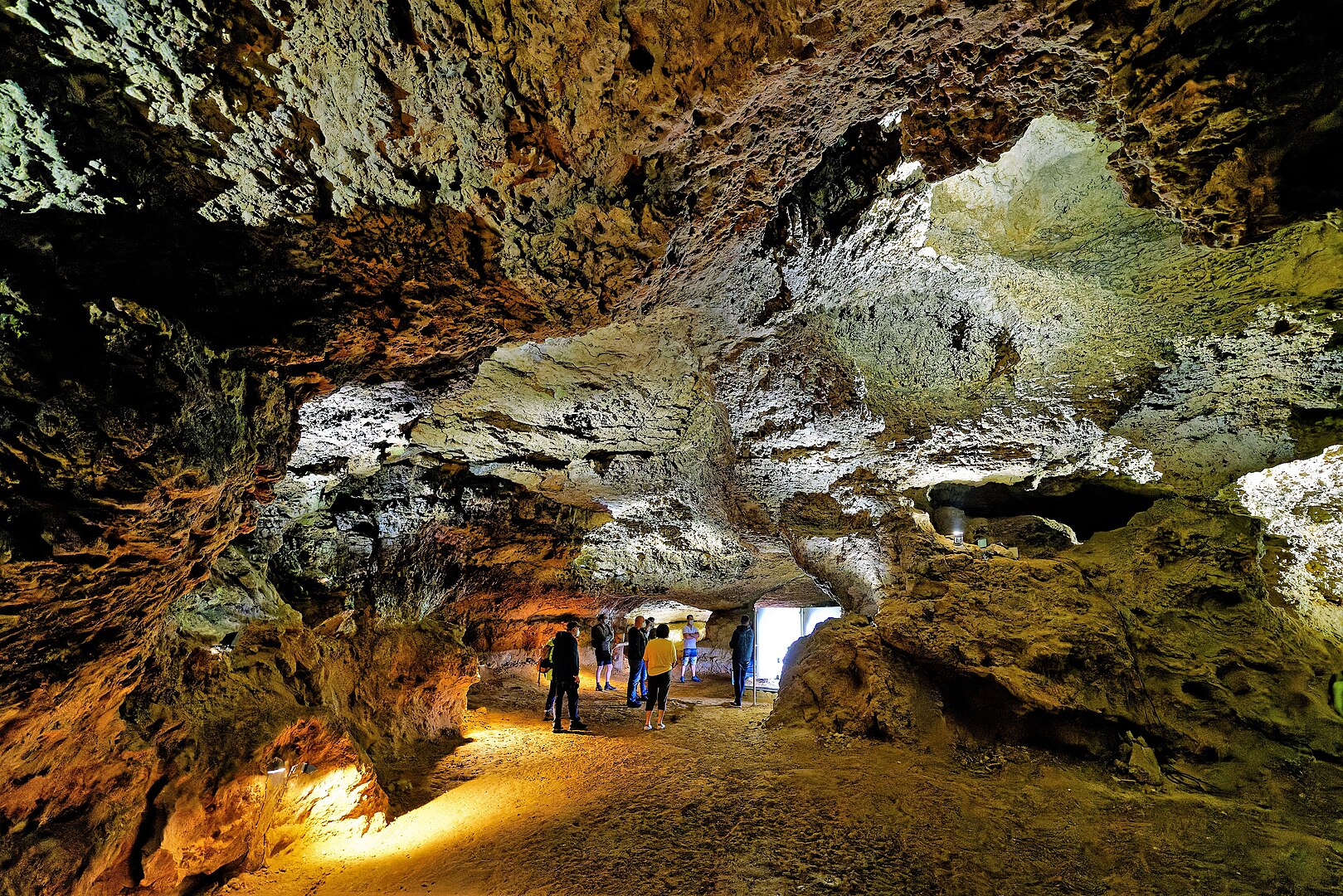
A Beer Lover’s Dream: Breweries, Beer Hikes, and Franconian Flavor
Honestly, few places can match the number of breweries and beer experiences you’ll find in the Fränkische Schweiz. I found historic brewery trails, cozy beer gardens, and a world of flavors that made every hike feel even more rewarding.
Legendary Brewery Trails: Fünf-Seidla-Steig and Beyond
If you’re a beer fan in Bavaria, you can’t skip the Fünf-Seidla-Steig. This trail links five independent breweries scattered across neighboring villages. I kicked things off in Weissenohe, where the Klosterbrauerei (Monastery Brewery) pours its famous Bonator Doppelbock. That strong, malty beer warmed me up and kept my spirits high on chilly mornings.
Every stop felt a little different. Elch-Bräu in Thuisbrunn served up a crisp Landbier in a cozy, rustic brewpub. At Brauerei Hofmann and Lindenbräu, I tasted fresh Vollbier—hearty, flavorful, and so distinctly Franconian. The path itself wound past shaded beer gardens, rolling fields, and brewpubs just begging you to linger a while.
I wandered off the main route and found the Brauereienweg near Aufseß, which links even more small breweries. With about 300 breweries in Franconia, there’s always a new trail, a new pint, and some new village to stumble into. All I really needed? A decent map and a thirst for adventure.
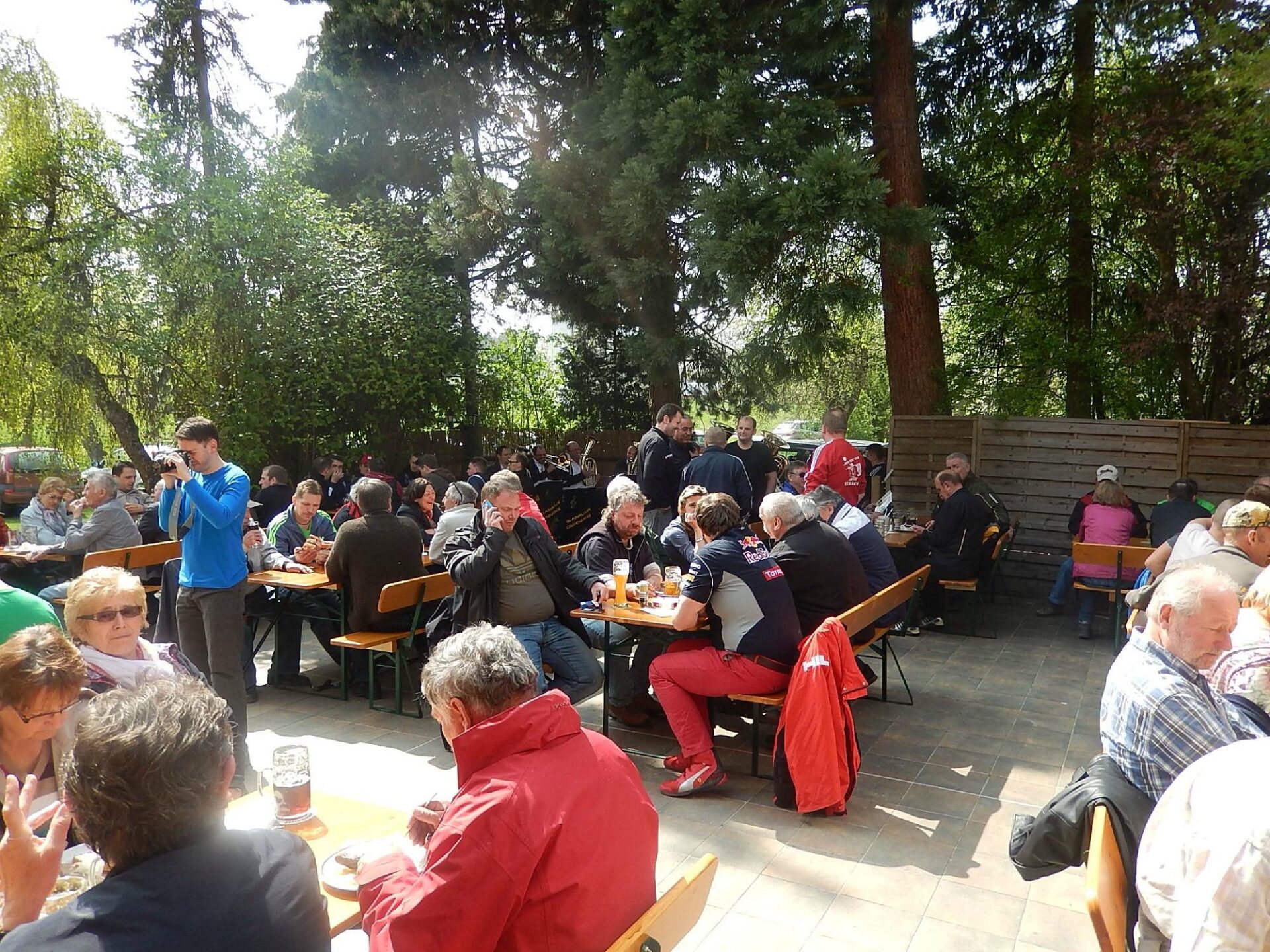
Breweries, Beer Gardens, and Regional Specialties
Sitting in a Franconian beer garden is honestly one of the best parts of the trip. Every brewery seems to have its own shady garden—usually under big chestnut trees—with long bench tables where locals chat and clink glasses. The gardens fill up with people enjoying fresh pretzels, Bratwurst, Obatzda (that addictive cheese spread), and plates of regional food.
Some spots, like Elch-Bräu, throw summer beer festivals with live music. Others, like Lindenbräu in Gräfenberg, serve up house brews alongside local snacks. Even the tiniest villages—take Tiefenellern—hide backyard breweries where families pour Landbier for whoever happens by.
Wherever I landed, I’d order a “Seidla” (that’s a half-liter glass) of the house specialty. Usually, I’d pair it with local sausage or just a slab of rye bread topped with onions and cheese.
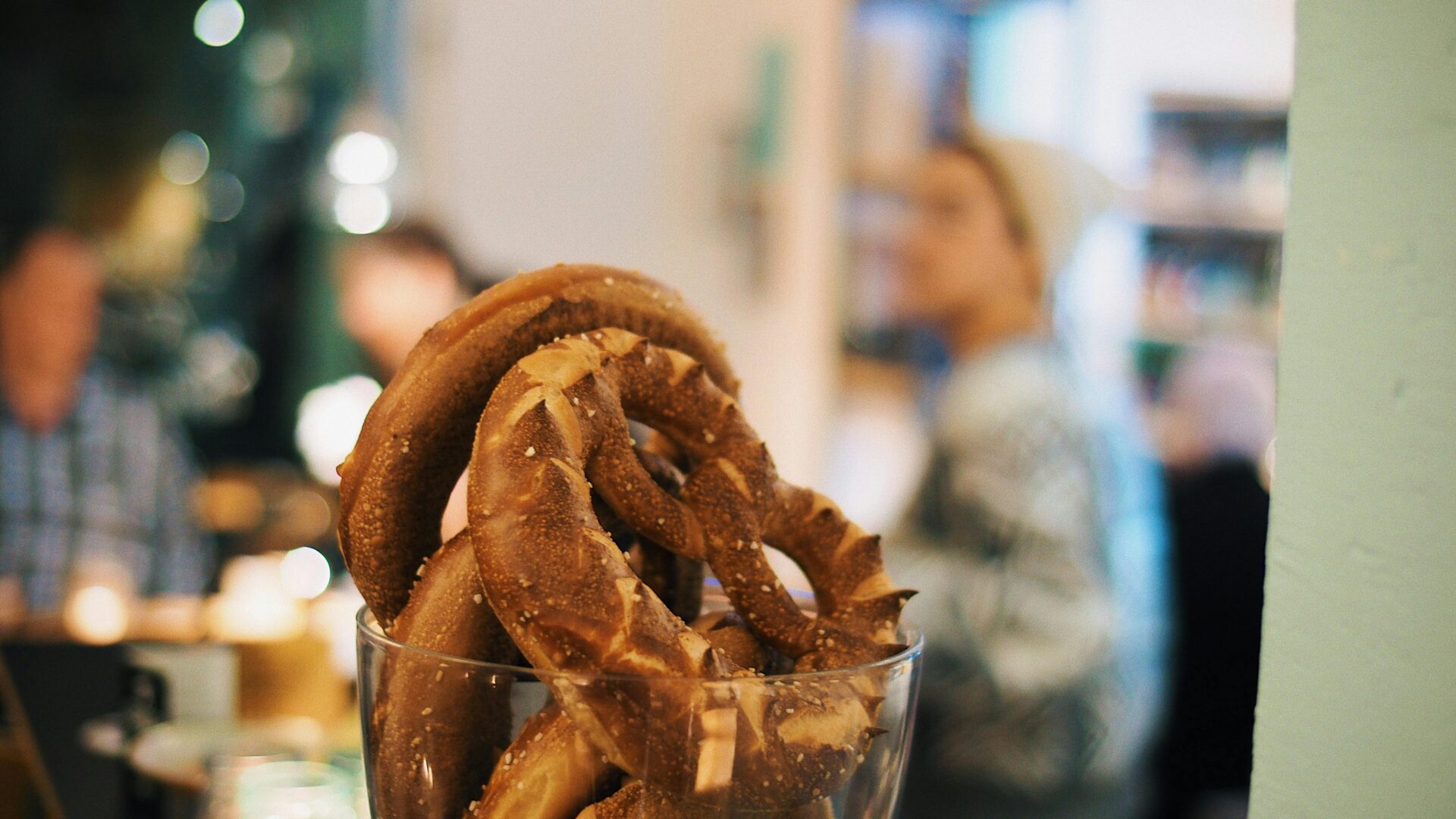
Unforgettable Beer Hikes in the Fränkische Schweiz
Hiking in the Fränkische Schweiz means following trails through forests, past limestone cliffs, and into tiny villages—each one with its own brewery. The region is packed with official beer hiking routes, like the Brauereienweg in Aufseß or the Bamberger Bergbier trail.
To plan, I relied on local trail markers and a trusty printed Komoot map. That helped me check distances and brewery opening hours, which can be a bit unpredictable. Each hike offered new countryside views and local flavors—and I never had to worry about parking or traffic.
I made up my own routes by linking breweries and beer gardens I’d heard about. Sometimes, I’d end up at a cellar shaded by old oaks, watching families play while I tried a glass of Festbier brewed right there. It’s such a good way to connect with Franconian culture, taste amazing beer, and slow down enough to actually see the landscape.
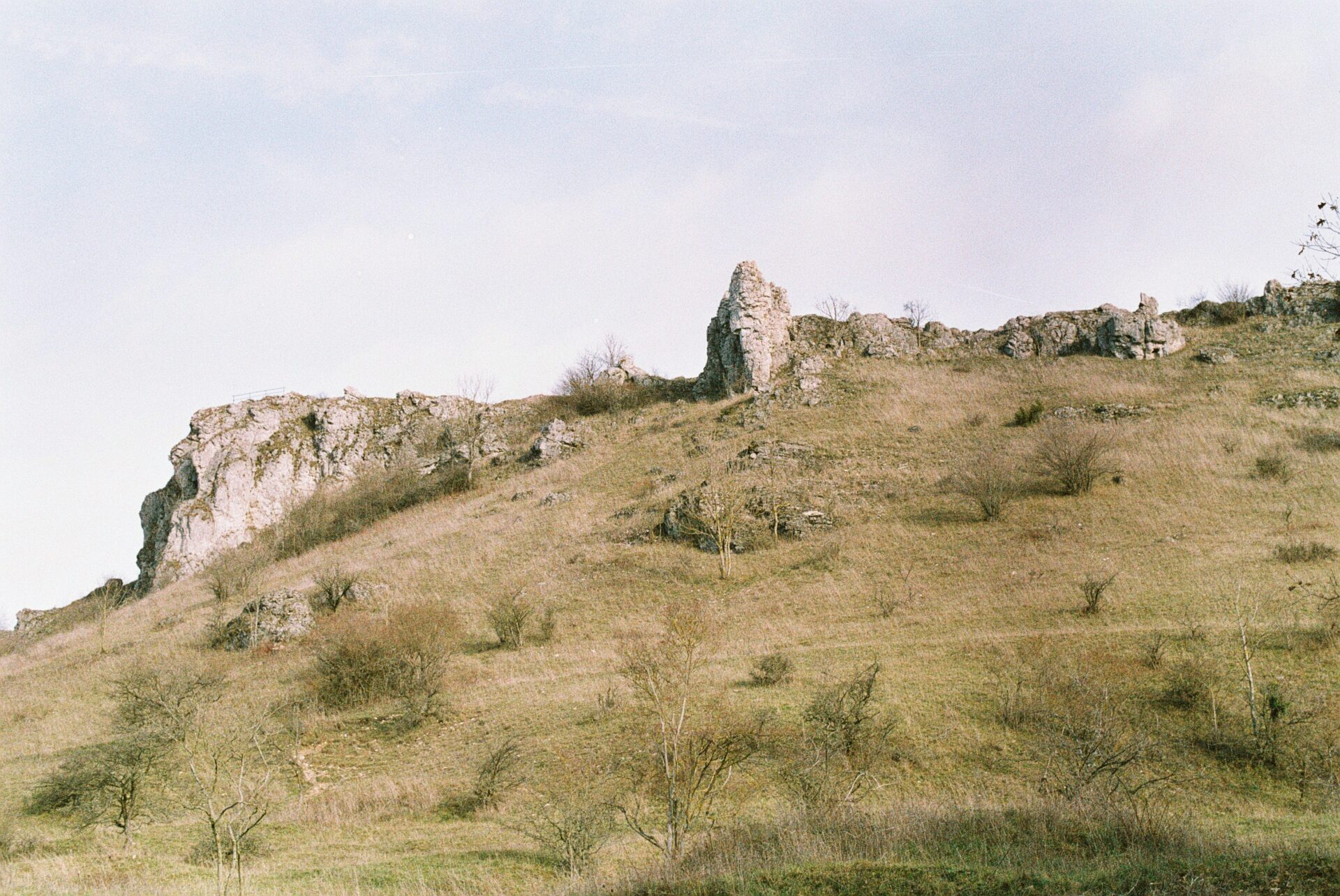
Tasting Rauchbier, Vollbier, and the Local Styles
Franconia’s beers are as varied as its scenery. Vollbier is everywhere—amber, a little sweet, and really satisfying. Each brewery pours its own take, and I was honestly surprised by how much they could differ, even along the same trail.
Rauchbier (smoked beer) from Bamberg was a game-changer for me. Its smoky aroma made me think of campfires, and the flavor was deep—perfect with roasted meats or hearty bread. Other styles I ran into: Pils (crisp and hoppy), Landbier (malty, rustic, usually unfiltered), and Festbier, which they brew for festivals.
Here’s a quick rundown:
| Beer Style | Key Flavor Notes | Best Pairing |
|---|---|---|
| Vollbier | Malty, creamy, smooth | Cold cuts, pretzels |
| Rauchbier | Smoky, rich, earthy | Sausages, smoked ham |
| Landbier | Malty, unfiltered, rustic | Hearty bread, cheese |
| Festbier | Malty, balanced, seasonal | Roast meats, salads |
| Pils | Crisp, bitter, refreshing | Light snacks |
Tasting beer in Franconia isn’t just about having a pint. It’s a way into the region’s traditions, flavors, and the people who keep them going.

Villages, Festivals, and Authentic Franconian Experiences
Between winding rivers and sandstone cliffs, I wandered through historic villages and tasted local specialties. The mix of medieval charm, lively festivals, and warm hospitality made every day memorable.
Medieval Towns and Architectural Gems
Franconian Switzerland is full of medieval towns that look straight out of a fairytale. I spent hours on cobbled streets, admiring half-timbered houses and poking around castle ruins. Bamberg, a UNESCO World Heritage site, charmed me with its cathedral and winding alleys. Rothenburg ob der Tauber’s medieval walls and rooftops felt frozen in time.
I visited Bad Staffelstein to see the baroque Vierzehnheiligen Basilica—its soaring ceilings were just stunning. Bayreuth, famous for Richard Wagner and the ornate Margravial Opera House, mixed music history with bold architecture. Even small villages like Ebermannstadt and Pottenstein surprised me. They welcomed visitors with cozy inns and ancient churches.
Here’s a look at a few favorites:
| Town | Notable Features |
|---|---|
| Bamberg | UNESCO site, historic breweries |
| Rothenburg | Medieval walls, Christmas museum |
| Bayreuth | Wagner festival, opera house |
| Bad Staffelstein | Vierzehnheiligen Basilica, thermal baths |
| Pottenstein | Castle, caves, summer toboggan run |

Annual Events and Beer Festivals
No one throws a party like the Franconians. I lucked into a few wild annual festivals. Local breweries set up open-air gatherings where everyone digs into hearty food and mugs of regional beer. The “Annafest” in Forchheim is a classic. I joined the crowds under oak trees, sampled smoked beer, and listened to live folk bands all day and night.
In Bamberg, beer cellars fill up fast during festival season. Every small town seems to have its own unique events, often with parades, costumes, and music. There’s more than beer, too—Bayreuth’s Wagner Festival pulls in music lovers from everywhere.
I found it easiest to check local calendars before visiting, since dates and activities can change. No matter what, I’d show up hungry and ready to see what happens.
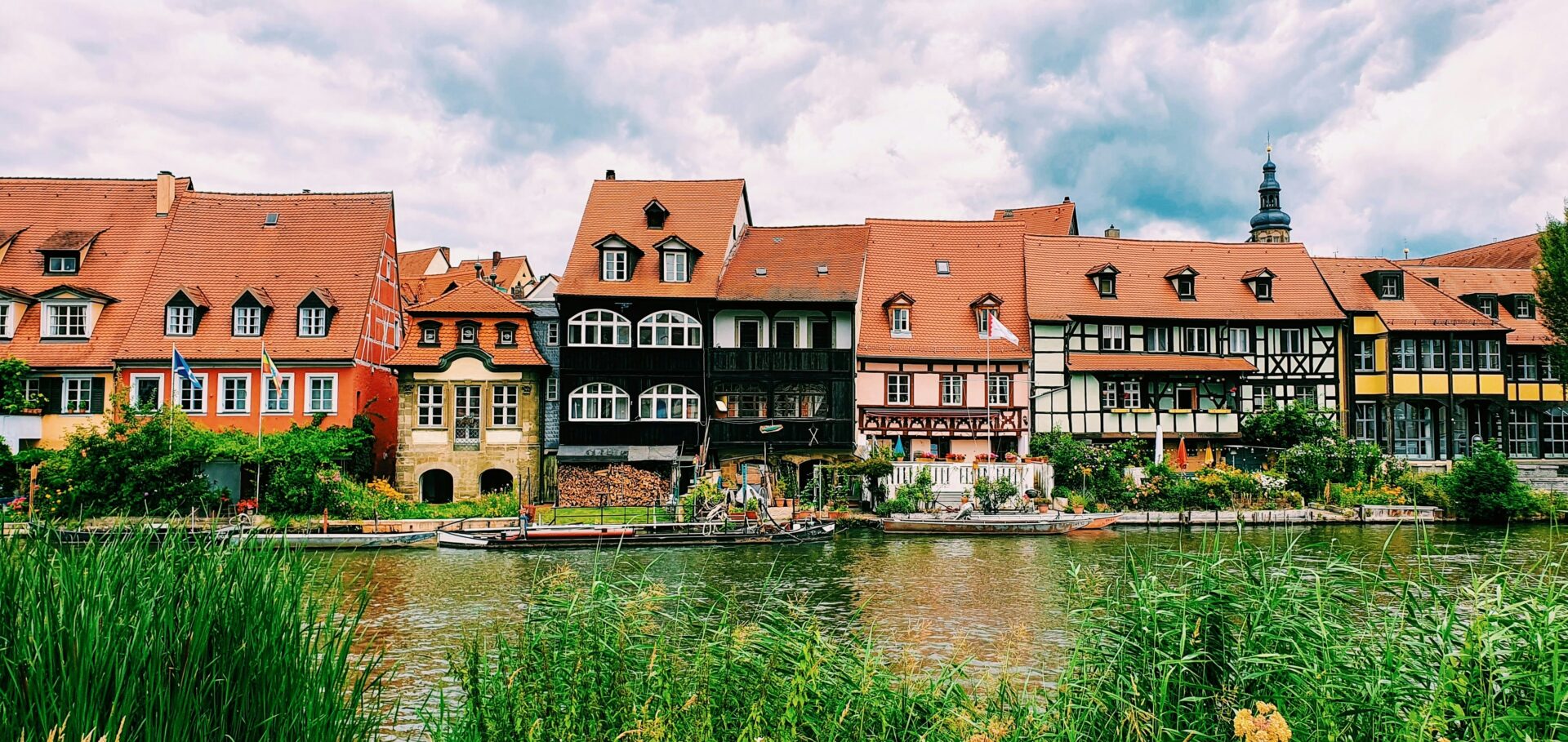
Museums, Culture, and Music
Culture in Franconian Switzerland runs deep. I spent a morning in folk museums learning about traditional Franconian crafts and customs. In Bayreuth’s New Palace, I wandered through art collections, then checked out the Richard Wagner Museum. Music is everywhere here.
The Bayreuth Festival is a must for classical fans, with performances in the opera house designed by Wilhelmine. But not everything is highbrow—local taverns often host musicians playing folk songs, especially in Bamberg or Aschaffenburg. Every stop felt tied to the area’s history, whether it was an organ concert or a pottery display.
For something different, I’d suggest the Bamberg Historical Museum or the Castle Museum in Pottenstein. Both are great for rainy days or when you want to dig into the region’s past.

Christmas Markets and Seasonal Delights
Winter in Franconian Switzerland brought out some of the coziest Christmas markets I’ve seen. The air filled with the smell of roasted almonds, mulled wine, and gingerbread. Rothenburg ob der Tauber’s Reiterlesmarkt was magical, with glowing stalls under medieval towers.
Bamberg’s Advent market mixed a historic setting with local crafts. I’d sip Franconian wine or punch, try cheesy pretzels, and wander for wooden ornaments. Even small towns put on charming displays—choirs, nativity scenes, and handmade gifts everywhere.
I loved the seasonal treats—sausages grilled over coals, sweet pastries, and local beer or wine. Walking the markets in the cold, wrapped in lights, made the trip feel like a real holiday.

Practical Tips for the Ultimate Franconian Switzerland Journey
Getting around Franconian Switzerland takes a bit of planning, but it’s always worth it. Timing, good places to stay, and smart packing really make a difference.
Travel Planning and Best Times to Visit
Timing matters. I found late spring (May–June) and early fall (September–October) just about perfect. Trails are green, weather is mild, and most places are open but not too crowded. July and August get busy, especially in Pottenstein and Egloffstein—both worth a visit, though.
If you want to catch local festivals or beer events, check the calendars. Public transport works in bigger towns, but I found renting a car gave me more freedom to explore the valleys and castles. I started my route in Strullendorf, which you can easily reach by train from Bamberg.
Some caves and castles have limited opening hours in winter, so always double-check before you go.
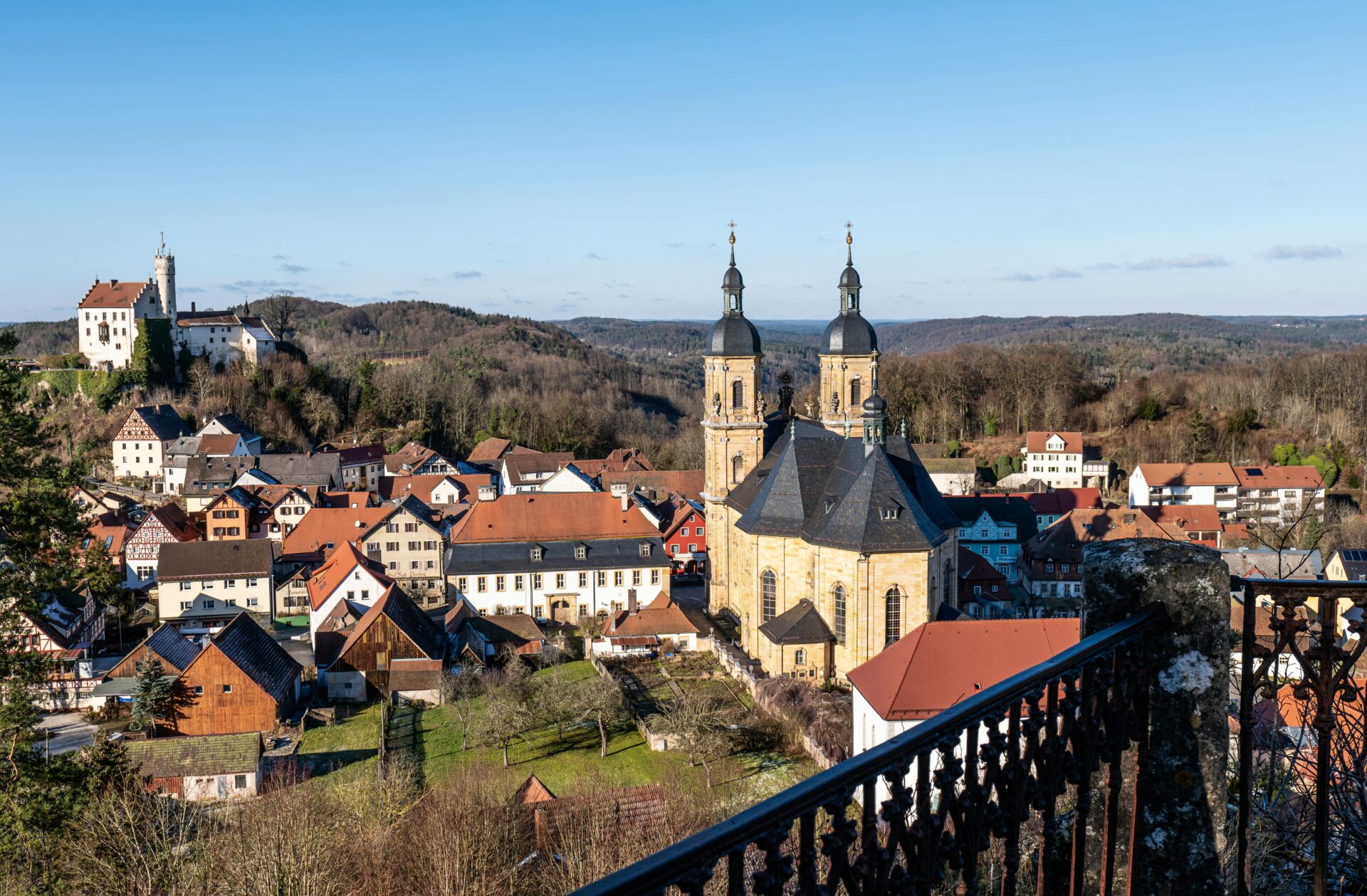
Where to Stay: Cosy Inns and Unique Lodging
Staying local made the experience. I loved the traditional guesthouses in Pottenstein—homemade bread, fresh hops on the table, and a warm welcome. Small inns (Gasthof) or private rooms (Zimmer) are everywhere in Franconian Switzerland. Many offer big breakfasts and can suggest bike routes or secret cellar tours.
A few picks from my trip:
| Town | Type | Features |
|---|---|---|
| Egloffstein | Family-run inn | Castle views, garden |
| Pottenstein | Brewery hotel | Local beer tasting |
| Strullendorf | B&B, Apartments | Train access, bakery |
Booking ahead is smart, especially in summer or during festivals. I met a few travelers who camped, but honestly, nothing beats a cozy inn after a long hike.
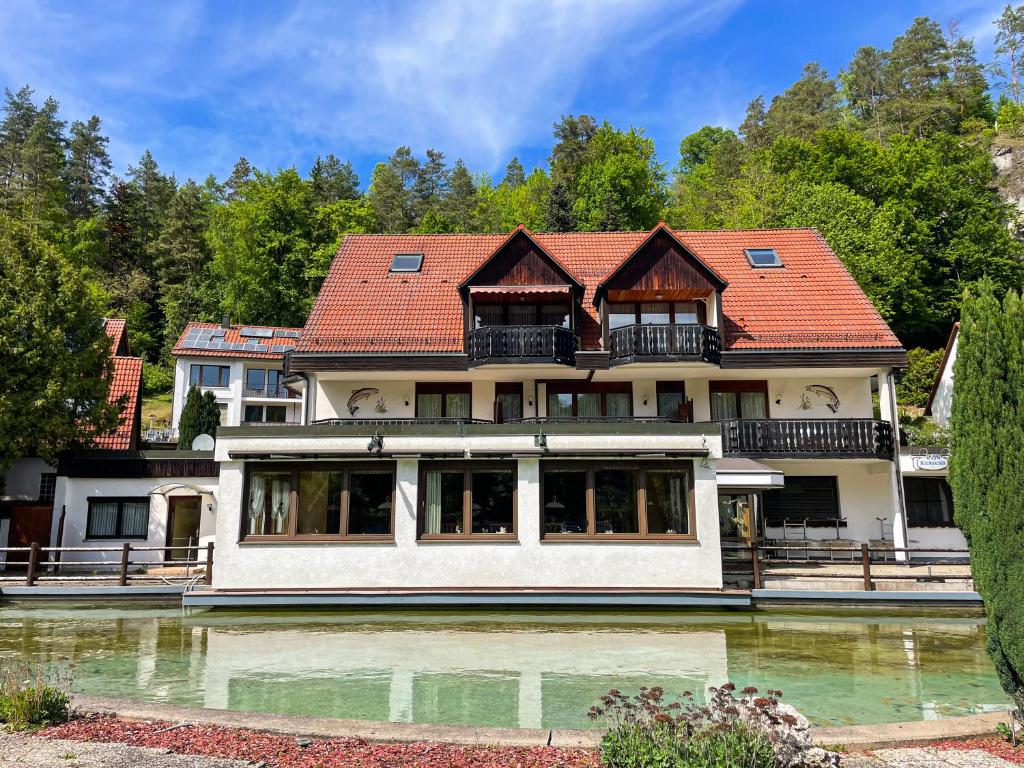
Essential Packing and Local Know-How
Packing right honestly made all the difference for me. You really need good walking shoes; the trails go from soft forest paths to some pretty rough castle climbs.
A waterproof jacket? Absolute lifesaver. Spring showers show up out of nowhere, and I got caught more than once. I always tossed a reusable water bottle in my bag—most town fountains or inns happily refilled it for free.
I’d suggest a small daypack and, honestly, an old-school paper map. Some areas just don’t have cell signal, and you don’t want to get stuck. A German phrasebook helped me out, too.
Oh, and cash is king in those tiny village bakeries and breweries. I kept a little wallet with euros just in case.
Whenever I tried a few German words, locals usually offered tips or directions. It felt nice, honestly. Watch out for brewery hours, though—some places close way earlier than you’d expect.
Sundays get really quiet, so I tried to respect those chill village vibes.

